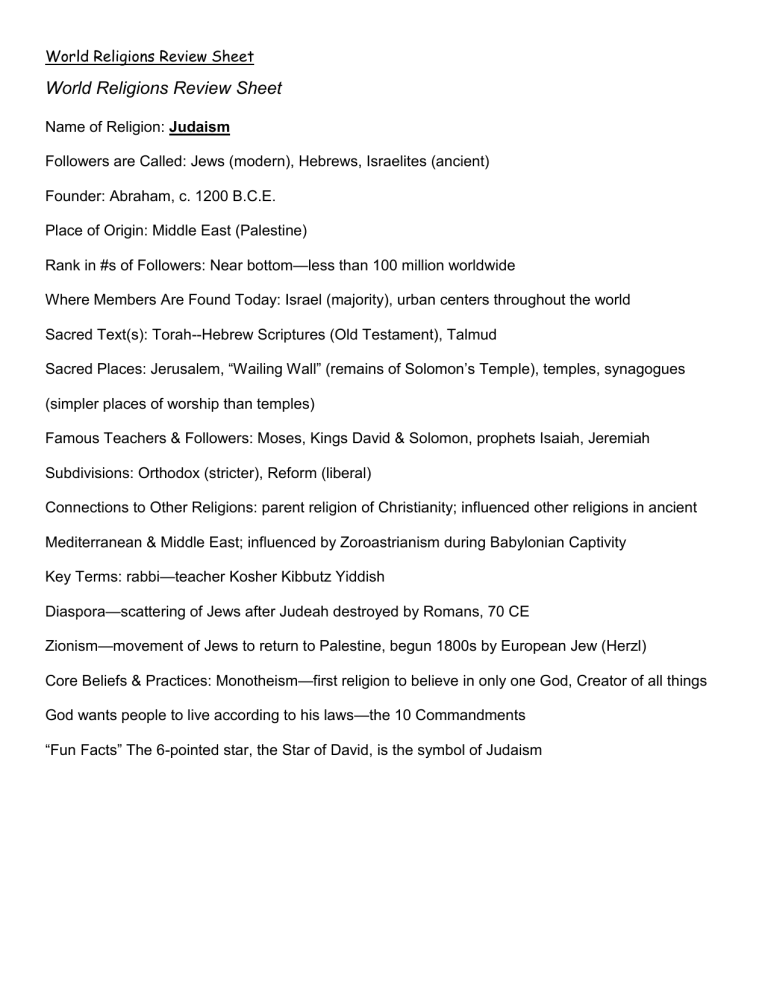World Religions Review Sheet

World Religions Review Sheet
World Religions Review Sheet
Name of Religion: Judaism
Followers are Called: Jews (modern), Hebrews, Israelites (ancient)
Founder: Abraham, c. 1200 B.C.E.
Place of Origin: Middle East (Palestine)
Rank in #s of Followers: Near bottom
—less than 100 million worldwide
Where Members Are Found Today: Israel (majority), urban centers throughout the world
Sacred Text(s): Torah--Hebrew Scriptures (Old Testament), Talmud
Sacred Places: Jerusalem, “Wailing Wall” (remains of Solomon’s Temple), temples, synagogues
(simpler places of worship than temples)
Famous Teachers & Followers: Moses, Kings David & Solomon, prophets Isaiah, Jeremiah
Subdivisions: Orthodox (stricter), Reform (liberal)
Connections to Other Religions: parent religion of Christianity; influenced other religions in ancient
Mediterranean & Middle East; influenced by Zoroastrianism during Babylonian Captivity
Key Terms: rabbi —teacher Kosher Kibbutz Yiddish
Diaspora
—scattering of Jews after Judeah destroyed by Romans, 70 CE
Zionism —movement of Jews to return to Palestine, begun 1800s by European Jew (Herzl)
Core Beliefs & Practices: Monotheism —first religion to believe in only one God, Creator of all things
God wants people to live according to his laws
—the 10 Commandments
“Fun Facts” The 6-pointed star, the Star of David, is the symbol of Judaism
Name of Religion: Hinduism
Followers are Called: Hindus
Founder: unknown (too old)
Place of Origin: India, 1500-500 BCE (Vedic Age)
—world’s oldest living faith
Rank in #s of Followers: #3, after Christianity & Islam —close to a billion
Where Members Are Found Today: South Asia, SE Asia, scattering worldwide
Sacred Text(s): Vedas (Rig Veda), Upanishads, Bhagavad Gita —sacred language Sanskrit
Sacred Places: Ganges River, many shrines around India & Pakistan, temples
Famous Teachers & Followers: Mahatma Gandhi
Subdivisions: Many popular cults devoted to various gods: Shiva, Vishnu,others
Connections to Other Religions: Many common elements with Buddhism, which grew from a Hindu
“root;” most notably, samsara & karma
Key Terms: samsara
—reincarnation
Karma —‘What goes around, comes around”
Moksha —“Hindu heaven”—dreamless sleep achieved by escaping reincarnation
Ashram
—Gandhi’s word for a community
Core Beliefs & Practices:
Caste system (varna), subcastes (jati) by occupation
Sati —widow suicide on husband’s funeral pyre
Dutiful devotion to one’s station in life brings spiritual advancement
Respect for all creatures
“Fun Facts” Some Hindus wear a red dot in the middle of their foreheads
Name of Religion: Zoroastrianism
Followers are Called: Zoroastrians
Founder: Zoroaster/Zarathustra, the “Persian Prophet”
Place of Origin: ancient Persia, c. 7 th
-6 th centuries BCE
Rank in #s of Followers: Near bottom —few left
Where Members Are Found Today: Israel (majority), urban centers throughout the world
Sacred Text(s): the Avestas
Sacred Places:
Famous Teachers & Followers: the magi, Zoroastrian priests
Subdivisions:
Connections to Other Religions: Influenced Judaism (monotheism, good & evil, stories), Mithraism
Key Terms:
Core Beliefs & Practices:
Life is a struggle between good & evil
People should choose good —good will prevail
Ahura Mazda
—god of goodness & light
Several lesser deities (almost monotheistic)
“Fun Facts”
Name of Religion: Buddhism
Followers are Called: Buddhists
Founder: Siddartha Gautama (“the Buddha),
Place of Origin: northern India, 500s BCE
Rank in #s of Followers: Perhaps 4 th
—a few hundred million?
Where Members Are Found Today: East & SE Asia; scatterings in Europe & N. America
Sacred Text(s):
Sacred Places: stupas (shrines), especially monastery of Nalanda (Himalayas), other shrines & monasteries, temples
Famous Teachers & Followers: the Dalai Llama, Ashoka, Xuanzang
Subdivisions: Mahayana Buddhism
—less strict, emphasized bodhisattvas (“Buddhist saints)
Theravada Buddhism —stricter form, popular in SE Asia
Zen (Chan) Buddhism
—first developed in China, became very popular in Japan—based on a combination of Daoism & Buddhism, more inspirational
Connections to Other Religions: grew out of Hinduism; some common elements (reincarnation, karma); influenced by Jainism (non-violence); Zen influenced by Daoism
Key Terms: nirvana —“Buddhist heaven”—freedom from reincarnation
Dharma
—core Buddhist teachings, dutiful way of living
Bodhisattva —“Buddhist saint” who has attained enlightenment
Core Beliefs & Practices: the Four Noble Truths & the Eightfold Path
People should overcome desire through right living & meditation
Impermanence —you shouldn’t get to attached to physical things
“Fun Facts”
Name of Religion: Daoism (“The Way” of Harmony)
Followers are Called: Daoists
Founder: Lao Tze
Place of Origin: China,
Rank in #s of Followers: not known, not an exclusive faith —millions to hundreds of millions— not the top 4, not the least
Where Members Are Found Today: Chiefly East Asia —scattering elsewhere
Sacred Text(s): I Ching
Sacred Places: temples
Famous Teachers & Followers:
Subdivisions:
Connections to Other Religions: often practiced together with Confucianism by Chinese; synthesized with Buddhism to produce Chan (Zen) Buddhism
Key Terms: wuwei —disengagement from worldly affairs
Core Beliefs & Practices:
Live in harmony & balance with nature
“Fun Facts” Yin Yang is the symbol of Daoist harmony
Name of Religion: Confucianism
Followers are Called: Confucianists
Founder: Kung Fu Tze (“Master Kung,” Confucius), a wandering sage
Place of Origin: China, c. 500 BCE during Period of Warring States between Zhou & Qin
Rank in #s of Followers: Below major world faiths —mainly Chinese
Where Members Are Found Today: China and Chinese-influenced areas (Korea, Vietnam)
Sacred Text(s): the Analects of Confucius
Sacred Places: temples
Famous Teachers & Followers:
Mencius —emphasized ren
Xunzi
—emphasized li
Subdivisions:
Connections to Other Religions: Daoism, neo-
Confucianism
Key Terms:
Ren
—kindness, benevolence
Li —respect, propriety
Xiao
—filial piety—respect for elders
Core Beliefs & Practices:
Relationships are key in establishing a good society
Confucian scholars should lead society
Examination system to find the best leaders
“Fun Facts”
Name of Religion: Christianity
Followers are Called: Christians
Founder: Jesus of Nazareth, c. 30 CE
Place of Origin: Palestine
Rank in #s of Followers: #1 —over a billion
Where Members Are Found Today: Huge in Latin America, Africa, N. America; scattering in Asia; declining in Europe
Sacred Text(s): Gospels, Bible (New Testament)
Sacred Places: Bethlehem, Nazareth, Jerusalem, churches, cathedrals
Famous Teachers & Followers: St. Paul, St. Augustine, St. Thomas Aquinas, St. Francis of Assisi,
Martin Luther, Martin Luther King, the popes
Subdivisions: Orthodox (Greek, Russian), Roman Catholic, Protestant (since 1517 —about 500 different denominations)
Connections to Other Religions: originally a Jewish sect —spread throughout Mediterranean by St.
Paul during
Pax Romana
—Christians accept many Jewish teachings, such as the 10 Commandments
Second great Abrahamic faith —monotheistic
God is a loving father/parent
—parable of the Good Shepherd, Prodigal Son
Key Terms: Sacraments —salvation—Messiah--crucifixion
Lent —40 day season of purification & repentance before Easter
Core Beliefs & Practices: People receive salvation from their sins by being reborn and accepting
Jesus as Messiah; people should follow Jesus’ teachings & example
Baptism Communion
—the “Lord’s Supper”
Christmas —Jesus’ birth
Easter —Jesus’ resurrection
“Fun Facts” The cross, representing Jesus’ crucifixion and sacrifice, is the symbol of Christianity
Name of Religion: Islam
Followers are Called: Muslims (Moslems)
Founder: Mohammed (Muhammad)
Place of Origin: Arabia, 600s CE
Rank in #s of Followers: Close second to Christianity —over a billion, & growing
Where Members Are Found Today: Middle East, central Asia ( the ‘Stans), Indonesia, north Africa
(majorities), scattering elsewhere
Sacred Text(s): the Holy Koran (Quran)
Sacred Places: Mecca & the Ka’aba, Jerusalem (Dome of the Rock)
Mosque —Islamic “church,” house of worship
Famous Teachers & Followers: ibn Rushd, the Sufis, ibn Khaldun, the Ayatollah Khomeini
Subdivisions: Sunni —90% globally—generally more secular
Shi’a (Shi’ites)—split over succession of caliphs in the early days, developed different traditions— dominant in Persia/Iran
Connections to Other Religions: Based on both Judaism & Christianity, whom Muslims revere as
“people of the book”
History of trouble with Hindus in south Asia
Key Terms: Allah (god)
The Hijra —Muhammad’s flight to Medina, beginning of the Muslim calendar
Sharia —Islamic law
Jihad
—holy war
Imam —Islamic religious leader
Qadi
—Islamic judge
Caliph —successor to Muhammad
Core Beliefs & Practices: The third great Abrahamic, monotheistic faith
The Five Pillars of Islam
1. Confession of Faith “There is no god but Allah, & Mohammed is his prophet”
2. Prayer five times a day
3. Giving alms to the poor
4. the Hajj
—pilgrimage to Mecca
5. Observing holy month of Ramadan
“Fun Facts” Muslims sometimes carry prayer rugs so they can pray wherever they are
The star & crescent are the symbol of Islam







